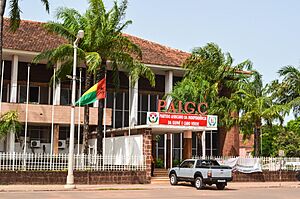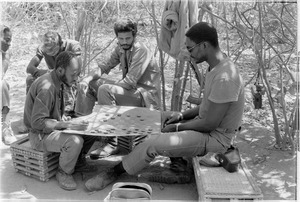African Party for the Independence of Guinea and Cape Verde facts for kids
Quick facts for kids
African Party for the Independence of Guinea and Cape Verde
Partido Africano para a Independência da Guiné e Cabo Verde
|
|
|---|---|
 |
|
| Abbreviation | PAIGC |
| Leader | Domingos Simões Pereira |
| Founder | Henri Labéry Amílcar Cabral |
| Founded | 19 September 1956 |
| Headquarters | Bissau, Guinea-Bissau |
| Youth wing | African Youth Amílcar Cabral |
| Women's wing | União Democrática das Mulheres da Guiné (UDEMU) |
| Ideology | Democratic socialism Social democracy Left-wing nationalism African nationalism Pan-Africanism Historical: Marxism Marxism-Leninism Democratic centralism Ethno-regionalism |
| Political position | Centre-left Historical: Left-wing |
| National affiliation | Inclusive Alliance Platform – Terra Ranka |
| International affiliation | World Anti-Imperialist Platform Socialist International (consultative) |
| Colors | Red, green and yellow |
| Slogan | Unidade e Luta ("Unity and Struggle") |
| National People's Assembly |
54 / 102
|
| Party flag | |
 |
|
The African Party for the Independence of Guinea and Cape Verde (known as PAIGC) is an important political group in Guinea-Bissau. It was first created to peacefully work for independence from Portugal. However, in the 1960s, the party started an armed fight. This led to the Guinea-Bissau War of Independence.
Near the end of the war, PAIGC set up a government where only one party was allowed. This system lasted until the early 1990s, when other parties were allowed. PAIGC won the first multi-party elections in 1994. But they lost power in the 1999–2000 elections. They returned to power after winning elections in 2004 and 2005. Since then, PAIGC has been the largest party in Guinea-Bissau's parliament, called the National People's Assembly.
PAIGC also governed Cape Verde from its independence in 1975 until 1980. After a military takeover in Guinea-Bissau in 1980, the Cape Verde branch of PAIGC became a separate party. This new party was called the African Party for the Independence of Cape Verde.
Contents
History of the PAIGC
How the Party Started
The PAIGC was founded in Bissau on September 19, 1956. It was first called the "African Party of Independence." The idea for the party came from a group started in 1954 by Henri Labéry and Amílcar Cabral. Six people started the party, including Amílcar Cabral and his brother Luís. Rafael Paula Barbosa became its first president, and Amílcar Cabral was the secretary-general.
Turning to Armed Struggle
In 1959, a sad event called the Pidjiguiti massacre happened. Portuguese soldiers shot at protesting dockworkers, killing 50 people. This event made many people support PAIGC's goal of independence. The massacre also convinced PAIGC leaders to fight Portugal with weapons. In September 1959, the party moved its main office to Conakry in nearby Guinea.
In 1961, PAIGC joined with similar groups from Mozambique and Angola. They formed the Conference of Nationalist Organizations of the Portuguese Colonies (CONCP). This group helped them work together to gain independence from Portugal.
The War for Independence Begins
The armed struggle against Portugal began in March 1962. PAIGC fighters attacked Praia, but it was not successful. Most of the fighting happened on the mainland of Guinea. It was too difficult to fight on the Cape Verde islands. Amílcar Cabral then ordered that PAIGC should focus on sabotage. This was to weaken the Portuguese until the PAIGC could get stronger.
On January 23, 1963, PAIGC started the Guinea-Bissau War of Independence. They attacked a Portuguese army base in Tite. They also attacked police stations in other areas.
International Support for PAIGC
In January 1966, Amílcar Cabral went to a big meeting in Havana, Cuba. He made a strong impression on Fidel Castro, Cuba's leader. Because of this, Cuba sent experts, doctors, and technicians to help PAIGC. The USSR and People's Republic of China also sent weapons like Kalashnikovs. These countries helped train the PAIGC fighters. Even SFR Yugoslavia sent some weapons in 1966.
Organizing the Fight
The first big meeting of the party happened in February 1964. It was held in a "liberated" area called Cassaca. At this meeting, PAIGC reorganized its political and military groups. They created a regular army called the Revolutionary Armed Forces of the People (FARP). This army worked alongside the guerrilla fighters.
The party also started a Pilot School in Conakry. This school, led by Lilica Boal from 1969, educated young fighters and children who had lost their parents in the war.
Key Battles and Portuguese Actions
Como Island was the site of a major battle between PAIGC and Portuguese forces. PAIGC took control of the island and fought off strong attacks from Portugal. The Portuguese even used airstrikes. Portugal launched "Operation Trident" to take back the island. The fighting was fierce, and Portugal suffered many losses. After 71 days, Portugal took the island back. However, PAIGC retook it less than two months later.
During the war, Portugal did not take PAIGC seriously at first. They sent soldiers and planes to other conflicts. By the time Portugal realized PAIGC was a big threat, it was too late. It became very dangerous for Portuguese soldiers to be far from their bases.
By 1967, PAIGC had attacked Portuguese bases 147 times. They controlled about two-thirds of Portuguese Guinea. In 1968, a new Portuguese governor, António de Spínola, arrived. He tried to win over the people by building schools, hospitals, and improving roads. PAIGC also worked with Sweden on a cooperation program.
In 1970, the Portuguese air force started using powerful weapons like napalm and defoliants. These were similar to what the US used in the Vietnam War. Spínola's time as governor marked a change. Portugal started winning more battles. In "Operation Green Sea," Portuguese troops raided Conakry. They freed 26 Portuguese prisoners of war. The USSR and Cuba then sent more weapons to Portuguese Guinea.
Steps Towards Independence
Between August and November 1972, PAIGC held elections for regional councils. These councils then chose members for a National Assembly. These were the first elections in the area where almost everyone could vote. About 78,000 people voted, and 97% supported the PAIGC candidates.
On January 20, 1973, Amílcar Cabral was killed. He was assassinated by a naval commander named Inocêncio Kani. This was part of a plan to overthrow the PAIGC leadership. But the plan failed, and 94 people were found guilty. Kani and at least ten others were executed.
Later that year, on September 24, 1973, Guinea-Bissau declared its independence. The United Nations recognized this independence in November. This was before Portugal officially recognized it. By the end of the eleven-year war, about 1,875 Portuguese soldiers and 6,000 PAIGC troops had died.
==Images for kids
PAIGC After Independence

After gaining independence, PAIGC became the only legal political party in both Guinea-Bissau and Cape Verde. Luís Cabral became the President of Guinea-Bissau. More elections were held in 1976 and 1977, with only PAIGC candidates.
PAIGC wanted Guinea-Bissau and Cape Verde to become one country. But this idea ended after a military takeover in November 1980. João Bernardo Vieira led this takeover against Luís Cabral. After this, the Cape Verde branch of PAIGC became a separate party.
Under Vieira, PAIGC continued to govern Guinea-Bissau in the 1980s and 1990s. Elections were held in 1984 and 1989, still with only one party. Vieira was re-elected as the party's leader in 1986.
Multi-Party Politics and Elections
In May 1991, Guinea-Bissau allowed multiple political parties. The first multi-party elections were held in 1994. For the first time, people could directly elect the president. Vieira won the presidential election, and PAIGC won 62 out of 100 seats in the National People's Assembly.
In 1998, Vieira was re-elected as the President of PAIGC. But a civil war started in June 1998. Vieira was removed from power in May 1999. Manuel Saturnino da Costa became the acting leader of PAIGC. Vieira was later removed from the party for "treason." Francisco Benante was then elected as the new President of PAIGC in September 1999.
In the 1999–2000 elections, PAIGC lost power for the first time. Their presidential candidate, Malam Bacai Sanhá, lost. PAIGC also became the third-largest party in the National People's Assembly.
PAIGC regained its position as the largest party in the 2004 elections. They won 45 out of 100 seats. In May 2004, Carlos Gomes Júnior, the party leader, became prime minister. In the 2005 presidential election, PAIGC's candidate, Malam Bacai Sanhá, lost to Vieira. Vieira had returned from exile and ran as an independent.
In March 2007, PAIGC formed an alliance with two other parties. They worked together to form a new government. This led to the removal of the prime minister, Aristides Gomes. Martinho Ndafa Kabi was appointed prime minister in April. However, PAIGC later stopped supporting Kabi in February 2008.
The PAIGC held its seventh big meeting in June 2008. Malam Bacai Sanhá challenged Gomes for the party leadership. But Gomes was re-elected for a five-year term as President of PAIGC.
After Kabi dismissed some government officials without telling the party, PAIGC left the alliance. Vieira then dismissed Kabi and appointed Carlos Correia as prime minister in August. In November 2008, PAIGC won two-thirds of the seats in the parliamentary elections. In the 2009 presidential elections, Sanhá won.
After Sanhá's death in January 2012, new presidential elections were held. Carlos Gomes Júnior was the PAIGC candidate. He made it to the final round, but a military takeover in April stopped the election.
General elections were held in 2014. PAIGC candidate José Mário Vaz was elected president. The party also kept its majority in the National People's Assembly, winning 57 out of 102 seats.
In the 2023 legislative election, PAIGC was part of a large group called the Inclusive Alliance Platform – Terra Ranka. This group won most of the seats.
Election Results Overview
PAIGC has participated in many elections since Guinea-Bissau became independent.
Presidential Elections
PAIGC candidates have won the presidential elections several times.
- In 1994, João Bernardo Vieira won.
- In 2009, Malam Bacai Sanhá won.
- In 2014, José Mário Vaz won.
The 2012 election was cancelled due to a military takeover.
National People's Assembly Elections
PAIGC has often been the leading party in the National People's Assembly.
- From 1976 to 1989, it was the only legal party.
- In 1994, it won a majority of seats.
- In 2004 and 2008, it won the most seats, forming governments.
- In 2014, it again won a majority.
- In 2019, it was the largest party but sometimes in opposition.
- In 2023, as part of an alliance, it won the most seats.
Foreign Support for PAIGC
During the Cold War, PAIGC received help from several countries. These included China, Cuba, the Soviet Union, Senegal, Guinea, Libya, Algeria, Poland, Czechoslovakia, and Ghana. This support helped them in their fight for independence and in governing the country.
See also
 In Spanish: Partido Africano para la Independencia de Guinea y Cabo Verde para niños
In Spanish: Partido Africano para la Independencia de Guinea y Cabo Verde para niños
- African independence movements
- Francisca Pereira














